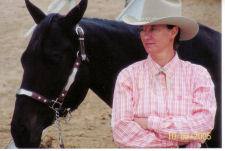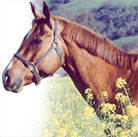| Article Archives
Starting
your own colt
Colt Starting
Quiz
Problem Horses,
part 1
Fear
Problems, part 2
Bad
Actors, part 3
The
Cold Backed Horse
Want
to Compete?
Bit Basics
Going
Places
Common
Sense, Horse Sense
Horsemen's
Christmas
Rainy Day
Training
Try Something
Different!
Green Broke
Resolution
Time
Going in
Circles
Hot Enough
for Ya?
Pleasure
or Equitation?
Return
to Work Carefully
Saving
your "Good Stuff"
Holding
Western Reins
Keep Your
Eyes on the Prize
Cold Weather
Warm Up
Expect
the Unexpected, 1
Expect
the Unexpected, 2
Bad Attitude
Horse of
a Better Color?
Power of
Exercise
Importance
of the Herd
Bath Time
Even Up
Choosing
a Martingale
Showmanship
A Good Night's Sleep
Alternative Therapies, Part One
Alternative Therapies, Part Two
Get the Most out of a Clinic
Blanket or No Blanket?
Does Practice Make Perfect?
A Change of Pace
The Power of Observation
On Line Horse Trading
The Right Horse at the Right Time
Putting On A Show
|
Weather or Not
With the turning of the season and the cooling temperatures at night, many horse owners are preparing for the wet, cold weather on the way. This often means tuning up the barn and corrals, cleaning out drainage ditches, and repairing or buying winter blankets. While horses in their natural state (the wilds) don’t rely on human intervention for shelter to survive, most of our horses need a little attention in order to come through winter in good shape.
A major consideration is shelter from wind and rain. Wild horses can travel to a more sheltered spot. When we go wilderness camping in Northern Nevada, we often find places against a bank or cliff that have the signs of horses loafing (manure and trampled earth) but unless your horses have a huge pasture with a variety of windbreaks available, it is best to offer some form of shelter. It doesn’t have to be fancy. A shed or run in, with a wall on the wind-ward side or even a solid fence that blocks the wind, will usually do the job as long as the horses are getting enough feed and are in good health going into the winter months. But, I often hear a similar complaint from horse owners; their horse won’t use the shelter that his owner has to thoughtfully provided!
There are many reasons why a horse will choose to stand huddled up and shivering in the rain when a perfectly good barn is only yards away. At least, to the horse there are perfectly good reasons! Sometimes it’s hard for us humans to see things from the horse’s perspective.
A well designed shelter needs to take some basic “horse sense” into consideration. Horses usually like to be able to see around them. It makes them feel safer. I have had horses who choose to stand behind the shed, using it as a windbreak, rather than go in if the shed was too confining. By adding a large overhang eve on the side that the horse preferred to stand on, we were able to make ourselves more comfortable (by not worrying about the horse) and still allow the horse to see all around. Noise is another factor. Some horses will not tolerate the sounds of rain on a metal roof, or loose roof panels banging. A gelding that loved his stall in the summer because it provided shade and shavings to lay down in, would stand out in the storms, soaking his blanket. When we locked him in, he would fret until he was just as wet as if he had been outside! But, moving him to another barn, which had a composite shingle roof instead of a metal one, solved the problem.
In a communal herd situation, I have had problems with one horse, of course the oldest mare who I felt needed the shelter the most, refusing to go into a shed when all the rest of the herd seemed to think it was the greatest place. This mare would even stand outside while the feed was in the long hay rack at the back of the shed, and so she was not getting any feed. Her issue was crowding – she did not like having to fight for space or deal with the other horses that were jostling for position and so we ended up moving her to a private corral and shed, where she cheerfully stayed under the roof for the rest of the winter.
Horses that were raised in stalls are more likely to associate them with comfort and safety than a horse who is used to being outside. These horses will often ask to be put in if they are turned out and it starts to rain. Some even like their blankets. But the outdoors-horse will appreciate some shelter, as long as it fits with the horse’s view of the world. Sometimes a small adjustment such as cutting a window into the shed wall, will make a lot of difference.
The other main consideration for winterizing your horse is feed. A fat, healthy horse will withstand a little rain if he chooses to stand out in it, but it will cost him in calories. Send your horses into winter with a little extra weight and keep a close eye to make sure he maintains it. Heavy winter coats can be deceiving, so at least once a week go in and do the “rib test” with your hands. Feeling down the side of the horse’s rib cage, note whether you can easily feel the individual ribs. There should be a nice padding over each rib bone. If you can easily feel ribs the horse needs more feed, or more high quality feed. My monthly feed bill doubles from November to April. I feed twice as much quality grass hay to all my horses during the winter season than I do in the spring and summer, and the grain/pellets consumption triples. I have several older horses who do fine all summer on permanent pasture but once that clover is gone, they get anywhere from 4 to 8 pounds of pelleted feed (I use Purina Mills Strategy GX) per feeding.
Yes, I know that I am spending the most money and effort during the time of the year when I ride the least ... but I know my horses will be ready to go and in good shape when spring rolls around.
 Doris
Eraldi of Eraldi Training in Potter Valley, specializes
in training for all around horsemanship. She can be
contacted at 707-743-1337, or by e-mail dyan@eraldi.net, or read her blog at Horseman's Diary Doris
Eraldi of Eraldi Training in Potter Valley, specializes
in training for all around horsemanship. She can be
contacted at 707-743-1337, or by e-mail dyan@eraldi.net, or read her blog at Horseman's Diary
<< Back
to Rainbow Ag Horse Home Page |
